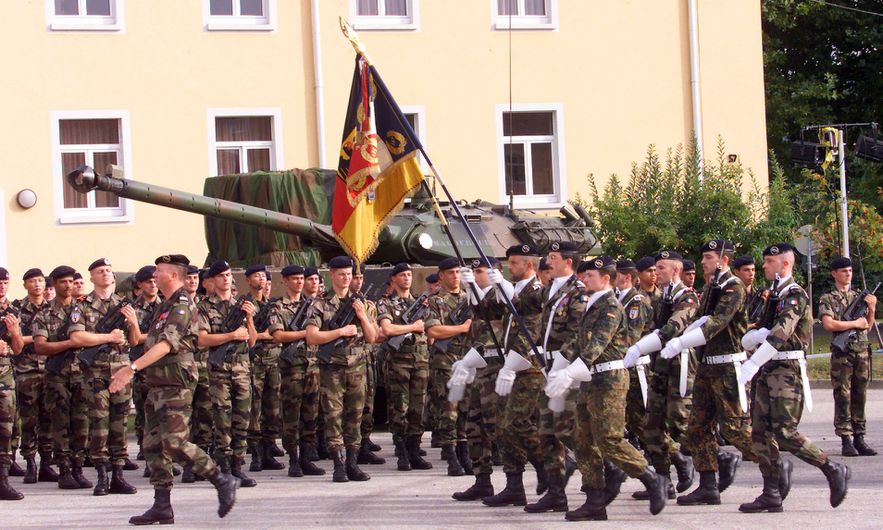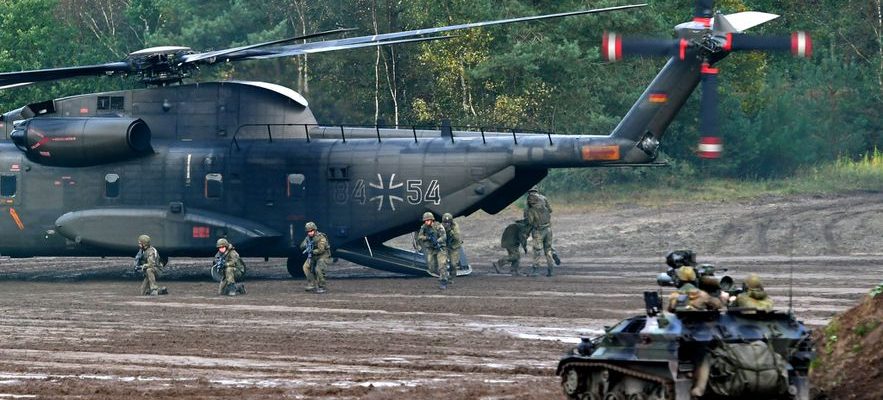Left dormant for years, the German army, the Bundeswehr, is gaining strength. The decision was taken just after Russia’s invasion of Ukraine, an event leading to a necessary “epochal change” for Germany. (“Zeitenwende”), as Chancellor Olaf Scholz called it. Thanks to a fund of 100 billion euros, Berlin is increasing orders, as part of a re-equipment program intended to make it the “first army in Europe”.
In a report inviting France to better understand the revolution underway on the other side of the Rhine – “The Bundeswehr facing the Zeitenwende” –, Elie Tenenbaum and Léo Péria-Peigné, from the security studies center of the French Institute of international relations (Ifri), examine the transformation of German military tools. “Germany has a single and clear strategic goal, while France is chasing three hares at once: to be a credible ally in Europe, not to let go of its presence in Africa and to be present in the Indo-Pacific space” , explains Léo Péria-Peigné to L’Express. Interview.
L’Express: The German government has announced that it will soon have the first army in Europe. Is she really taking the path?
Léo Péria-Peigné: Yes, but not in the way you might imagine at first glance. Poland also has the ambition to be the leading land army in Europe. But it thinks first of itself, while Germany aims for this in a European way. It is equipping itself with means of command, communication and logistical support, which will allow other nations to connect their armies to this system within the framework of NATO. Germany could thus become the first army by becoming the basis of a “European army”, but not necessarily in terms of number of tanks.
Many experts in Germany emphasize that the 100 billion euros in the special fund will mainly be used to make up for accumulated delays…
Yes, a bit like the French military programming law 2019-2025, the 100 billion euro fund is first and foremost a restoration plan, to make what exists work and densify certain lost capabilities. It will only last a few years, but will make it possible to achieve the objective of the equivalent of 2% of GDP devoted to defense, as recommended by NATO. The idea is that then, in 2027, the 2% will be provided by the normal defense budget, without additional funds. For the next German government, however, this will have to be politically acceptable. For this, it will be necessary that the Zeitenwende reaches consciousness.
Bundeswehr military maneuvers near Munster, Germany, October 13, 2017
© / afp.com/PATRIK STOLLARZ
How long will the Bundeswehr remain “dry”, with very little availability of equipment, as the head of its army said?
The situation is already slowly improving and this is expected to continue. For example, there was a big availability problem in the German navy, linked to the congestion in civilian shipyards. In 2017, none of Germany’s six submarines were capable of carrying out missions on short notice. The Navy therefore purchased infrastructure for its exclusive use to solve this problem. However, for the situation to improve in the long term, human resources must follow suit. Specialists and volunteers are needed to use the new equipment.
As Germany no longer has military service, it must attract talent, young people, with increasingly sophisticated skills. In an older country – much more so than France – this is already a problem. Added to this is the fact that the civilian job market is more attractive. If the Germans fail to attract new soldiers, the effect of revitalization will remain limited. There is work to be done to make the military role more attractive to young people.
Why does this “change of era” strengthen Germany’s partnership with the United States more than with France?
THE Zeitenwende will strengthen not only the partnership with the United States, very important for a Germany attached to NATO [NDLR : achat de nombreux appareils américains, en particulier des avions et des hélicoptères]. But it will also strengthen its partnership with other European countries, more than with France. For a fundamental reason: if, in Europe, Germany is France’s main partner, the opposite is not true. Its main partner is the Netherlands. Currently, the three brigades that make up the Dutch Army are fully integrated into the three divisions of the German Army.
Germany is thus developing partnerships with other European countries to integrate them into its force model and constitute a common platform. Others could be set up with Hungary, or with the armies of the countries bordering the Baltic Sea and their navies. This earned him some criticism in Paris, because Germany would thus provide the non-combatant functions to send other Europeans to the front in their place.
But France could seek to do the same thing with Belgium, as it has started to do with its strategic partnership on certain vehicles. A Luxembourg unit could also, in the long term, be integrated into the French divisions.

The Ministry of Defense announced Thursday the dissolution during 2014 of the 110th Donaueschingen infantry regiment, a French regiment stationed in Germany as part of the Franco-German brigade (BFA).
© / afp.com/Gerard Cerles
How do France and Germany differ in their objectives?
The French army sees itself as an employment army, which can wage war and intervene where it is needed, even far away. After the end of the USSR and reunification, Germany also embarked on a logic of international interventions, like in Afghanistan, but it did not really work, because it was too far from its own strategic culture focused on the defense of Europe. It returned to it from 2014: an army which must maintain a sufficient level of power to deter any potential aggressor, focused on high intensity. Germany therefore has a single and clear strategic goal, while France is chasing three hares at once: being a credible ally in Europe, not letting go of its presence in Africa and being present in the Indo-Pacific space, with 10% of its budget devoted to nuclear deterrence. The military programming law recorded this lack of choice.
Can we be sure that the two major Franco-German flagship programs, the SCAF (the plane of the future) and the MGCS (the tank of the future), will be carried out? ?
These projects were launched for political reasons and are moving slowly and chaotically on the military and industrial fronts. The armies do not want the same thing. Concerning the SCAF, the French want it to be able to land on an aircraft carrier and carry future ASM4G nuclear missiles. The Germans are not necessarily ready to pay for these capabilities, which do not interest them. Industrially, Airbus and Dassault have a very difficult relationship, as Airbus tried to buy Dassault in the early 2000s.
On the MGCS side, the project was to bring together the French Nexter, very good at manufacturing cannons, and KMW, the designer of the Leopard 2 hull. But the Bundestag demanded that Rheinmetall, a much larger defense company, be added. bigger than the other two. However, KMW fears being bought by Rheinmetall, whose 130 cannon is in competition with Nexter’s 140 cannon to equip the MGCS…
What should be done to relaunch a Franco-German partnership in defense?
Existing structures need to be revitalized and made relevant again. Let us know what we could do with the Franco-German brigade [NDLR : regroupant des soldats français et allemands]. For the navy, there was the Franco-German naval force [FNFA], a common training structure, which has fallen into disuse. On the Air Force side, cooperation structures are functioning, but they could be improved to be adapted with high-intensity joint training. Increasing the exchange of officers would also facilitate communication.
For the tank of the future, one solution would be to give meaning to the grouping of Nexter and KMW, called “KNDS”, by ordering a certain number of tanks using elements that the two companies have jointly proposed. This would allow partners to work together, and would give common equipment to both armies, in anticipation of the MGCS, especially since it is not certain that the French Leclerc tank fleet can last until 2040…
